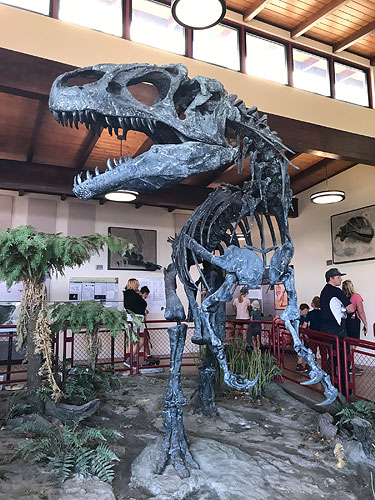 |
| Allosaurus in the visitor center. |
Jurassic Park is a name that has meaning for most Americans since it is one of the biggest grossing movies of all time and has worked its way into the American cultural lexicon. Jurassic National Monument, on the other hand, is a sleepy little national monument managed by the Bureau of Land Management. The monument located southwest of Price to the northeast of the San Rafael Swell. Although the bone bed in Jurassic National Monument is one of the most important fossil locales in the country, the monument isn’t even well known within the state. It is also the least visited national monuments in Utah.
Jurassic National Monument was designated in 2019 as part of the bipartisan Dingell Act. The Dingell Act increased protections for public lands and improvements to public land access, and established four new national monuments. The law enlarged Cleveland-Lloyd Dinosaur Quarry which had been managed as a Registered Natural Landmark since 1966.
The heart of Jurassic National Monument consists of the quarry where the bone bed is protected by small metal sheds. There, a variety of dinosaur bones, including Allosaurus, Stegosaurus and others, have been left in situ for public display. The quarry is in the upper part of the Brushy Basin Member of the Morrison Formation (one of the great dinosaur-bone-bearing rock layers in the American west), and is approximately 149 million years old. The bone bed is up to about a meter (3 feet) thick and contains a very dense concentration of dinosaur bones but few other types of fossils.
Active research is ongoing in the monument. Joe Peterson from the University of Wisconsin Oshkosh and Jonathan Warnock from Indiana University of Pennsylvania have been visiting the quarry for a few weeks each summer for the last dozen years. Their research objective is to not only excavate bones, but more importantly to conduct a “paleontological crime scene investigation,” in the words of Dr. Peterson in order to figure out the geologic history of the site.
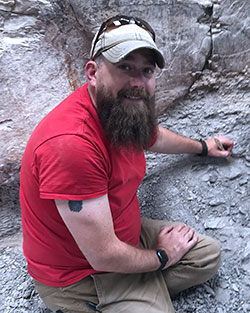 |
| Joe Peterson |
Dr. Peterson continued, “Dinosaur paleontology has a long checkered history. Early on, it was just ‘smash and grab’ and get the bones out of the ground. With Cleveland-Lloyd being so unique, we are trying some different approaches.”
By unique, Dr. Peterson means that the Cleveland-Lloyd quarry is one of the largest bone beds in the world and that it has an unusual assemblage of bones. Strikingly, approximately 66% of the fossils that have been recovered at the site are from Allosaurus, one of the main predators during Morrison time. Allosaurus was a therapod, a group of bipedal dinosaurs with hollow bones and three toes and claws on each limb.
The great concentration of Allosaurus bones relative to fossils of prey species is highly unusual. There is about a three to one ratio of Allosaurus to other types of dinosaurs. Allosaurus is so common at Cleveland-Lloyd that it is the second most common dinosaur recovered from the entire Morrison Formation, although it is not common at other fossil sites.
Over the years, paleontologists have proposed two hypotheses to explain the unusual features of the site. One that it was a predator trap akin to the famous La Brea Tar Pits in Los Angeles where a natural asphalt seep entrapped animals during the Pleistocene (last ice age). The other was whether geologic and environmental events somehow caused the bones to accumulate at the future quarry site.
To resolve this mystery, Dr. Peterson, Dr. Warnock, and their colleagues are using taphonomy (the study of how living things become preserved in the fossil record). They have obtained geochemical analyses, studied microfossils, evaluated the condition of the bones, and used techniques to create a three-dimensional map of the quarry including the orientation of individual bones. Putting these different lines of evidence together, they determined that the quarry site was once an ephemeral pond.
Dr. Peterson elaborated, “We think it is actually a seasonal deposit that dead dinosaurs were washing into. Think of an arid plain in the Serengeti. During the dry season, there would be a mass die off. And when the wet season came, it washed all of those bones into the site.”
Their research in the quarry site itself is a part of a larger effort to understand the geologic and paleontological history of Jurassic National Monument as a whole as well as to understand the larger ecosystem in which the Morrison Formation was deposited.
Cloning dinosaurs from DNA extracted from amber may be the stuff of science fiction in a movie, but Jurassic National Monument offers the opportunity to learn how paleontologists study fossils and the characteristics of the rocks in which they are found to solve a geologic whodunit like the one that led to such a great concentration of Allosaurus fossils in the Cleveland-Lloyd Dinosaur Quarry.
Jurassic National Monument is about 130 miles from Moab, with the last dozen miles via graded unpaved road. To learn more about the Cleveland-Lloyd Dinosaur Quarry, please visit www.blm.gov/national-conservation-lands/utah/jurassic-national-monument.
Special thanks to Joe Peterson.
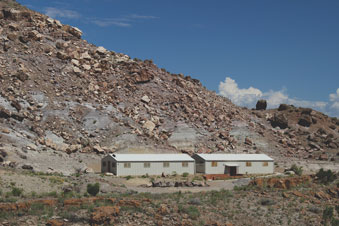 |
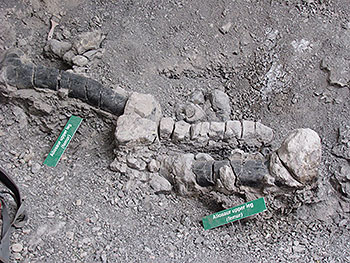 |
| The quarry sheds with a slope of the Brushy Basin Member behind them. |
Examples of some of the bones in the quarry. Because it is an active research site, the quarry changes from year-to-year. |
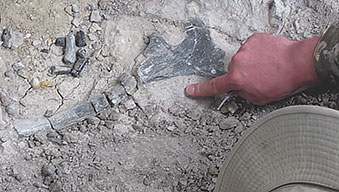 |
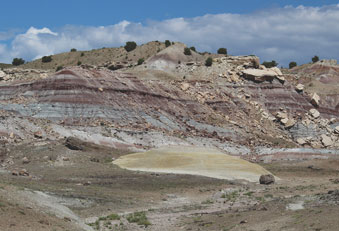 |
| An Allosaurus bone during excavation. |
Outcrops of the Brushy Basin Member add beauty to Jurassic National Monument. |
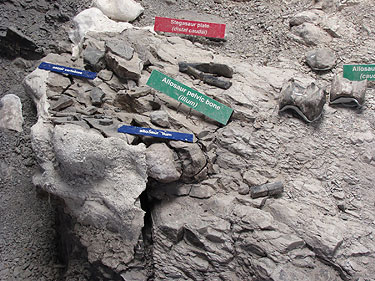 |
|